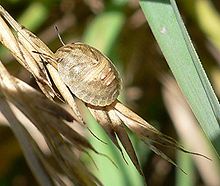Turtle bug
| Turtle bug | ||||||||||||
|---|---|---|---|---|---|---|---|---|---|---|---|---|

Turtle bug ( Eurygaster testudinaria ) |
||||||||||||
| Systematics | ||||||||||||
|
||||||||||||
| Scientific name | ||||||||||||
| Eurygaster testudinaria | ||||||||||||
| ( Geoffroy , 1785) |
The turtles Bug ( Eurygaster testudinaria ) is a throughout Europe spread Wanzenart from the family of scutelleridae .
features
The animals reach a body length of 9 to 11 millimeters. They have a variable brown basic color and pattern. The tylus (frontal wedge) is slightly lower than the cheeks lying to the side of it. The similar common grain bug ( Eurygaster maura ) is somewhat smaller, and the tylus at the tip of the head lies on a level with the cheeks, which means that the tip of the head is evenly edged. In the turtle bug, the second link of the antennae is only about 1.5 times as long as the third, and in the common grain bug it is twice as long as the third. The back corners of the pronotum are also a little less prominent in the common grain bug. With the above-mentioned distinguishing features, however, the two species cannot always be clearly distinguished, so that a genital morphological examination is then necessary. In contrast to the similar species, the females have a gap between the genital plates and the abdominal segment in front of it, while in the males the aedeagus has four instead of two internal thorns.
distribution and habitat
The species occurs in Europe from the northern Mediterranean to southern Scandinavia and further east through central Asia to northern China and Japan. In Central Europe, the sometimes not uncommon species is widespread almost everywhere and is only occasionally missing regionally. Unlike the Common Getreidewanze, it colonizes more humid, open to partially shaded habitats such as tall sedge stands and moors and also occurs in salty places.
Way of life
They are found not only on sweet grasses (Poaceae), but also on sour grass plants (Cyperaceae) (e.g. cotton grass ( Eriophorum ), sedges ( Carex ), ledges ( Scirpus )) and rush plants (Juncaceae) (e.g. rushes ( Juncus )). Older nymphs and adults can also be found on sunflower (Asteraceae), umbellifers (Apiaceae) and other plants.
The nymphs suckle on the food plants between May and August, adults appear from July. The wintering takes place in dry litter , occasionally also in small groups.
supporting documents
Individual evidence
- ↑ a b c d e Eurygaster testudinaria. British Bugs, accessed November 18, 2013 .
- ↑ a b c Turtle bug - Eurygaster testudinaria (GEOFFROY, 1785). www.natur-in-nrw.de, accessed on November 18, 2013 .
- ^ A b c Ekkehard Wachmann , Albert Melber, Jürgen Deckert: Bugs. Volume 4: Pentatomomorpha II: Pentatomoidea: Cydnidae, Thyreocoridae, Plataspidae, Acanthosomatidae, Scutelleridae, Pentatomidae. (= The animal world of Germany and the adjacent parts of the sea according to their characteristics and their way of life . 81st part). Goecke & Evers, Keltern 2008, ISBN 978-3-937783-36-9 , pp. 71 .
literature
- Ekkehard Wachmann , Albert Melber, Jürgen Deckert: Bugs. Volume 4: Pentatomomorpha II: Pentatomoidea: Cydnidae, Thyreocoridae, Plataspidae, Acanthosomatidae, Scutelleridae, Pentatomidae. (= The animal world of Germany and the adjacent parts of the sea according to their characteristics and their way of life . 81st part). Goecke & Evers, Keltern 2008, ISBN 978-3-937783-36-9 .
Web links
- Eurygaster testudinaria at Fauna Europaea


